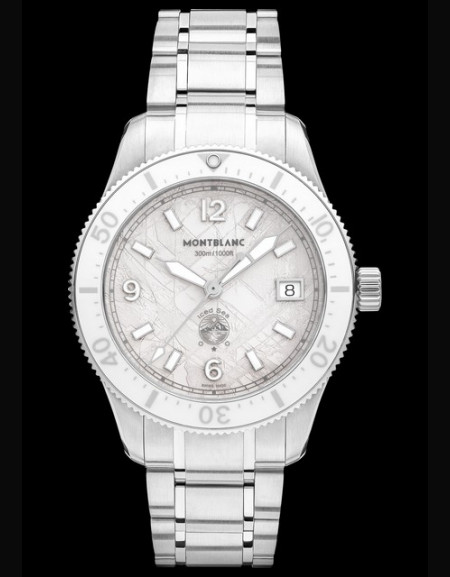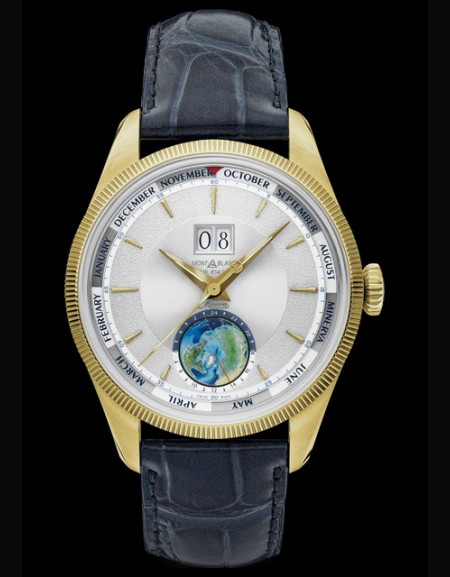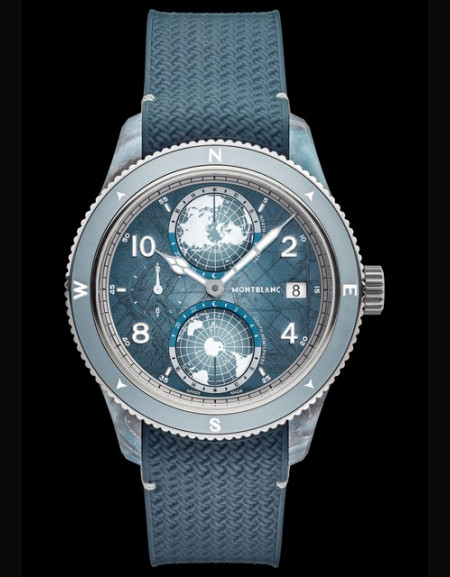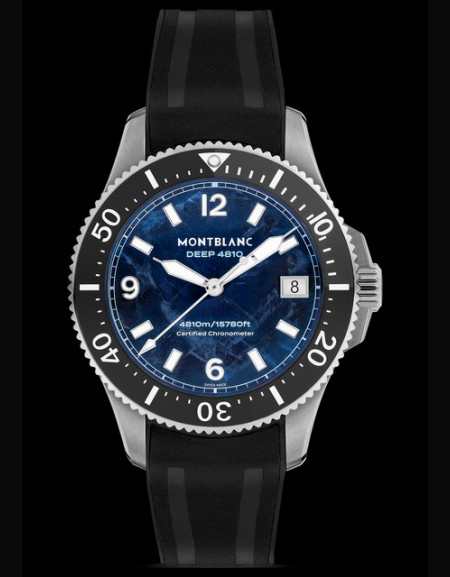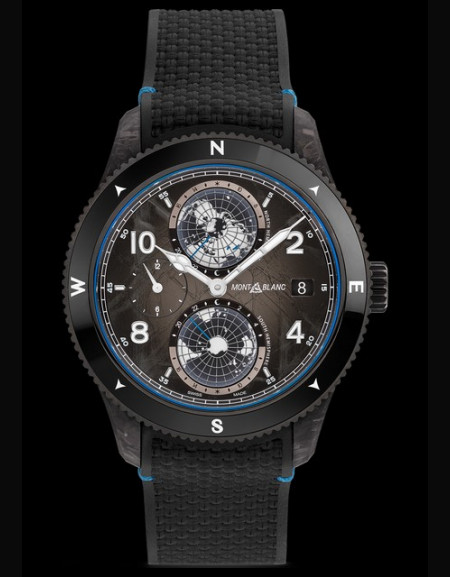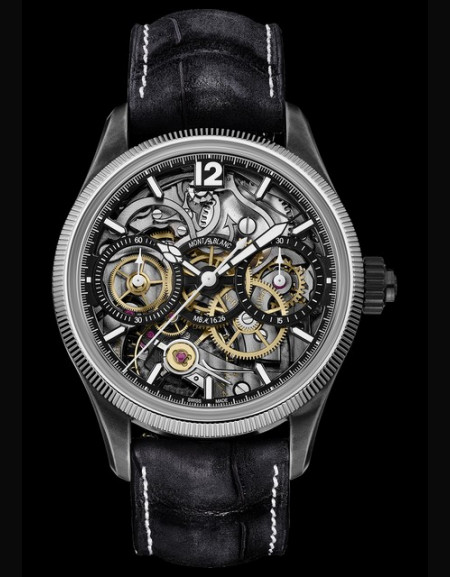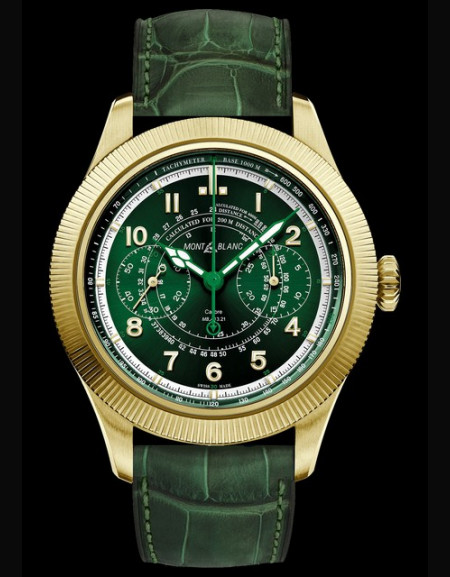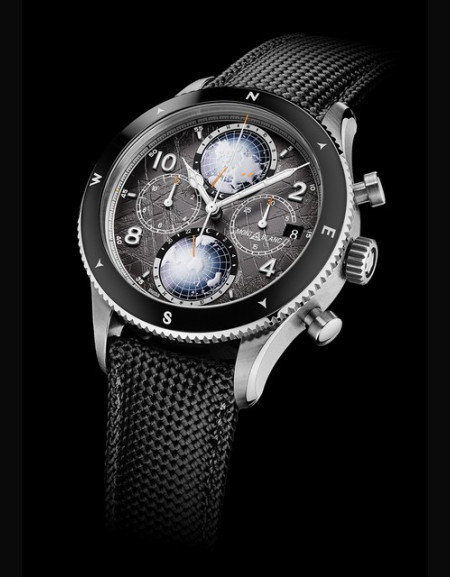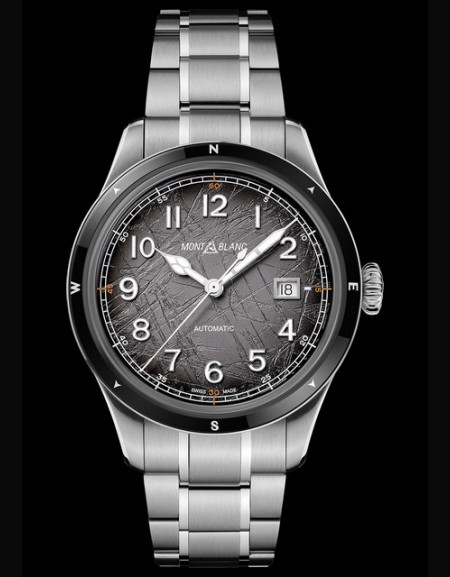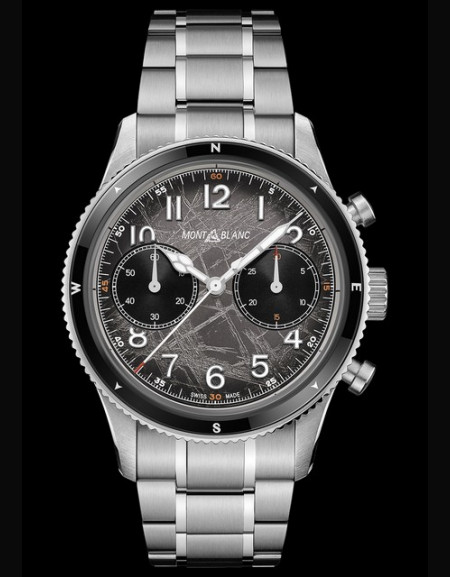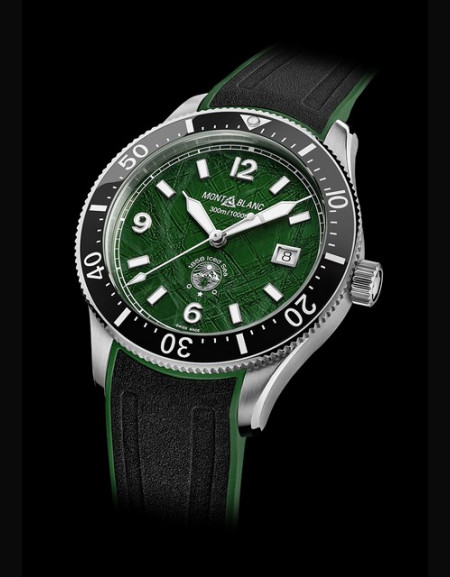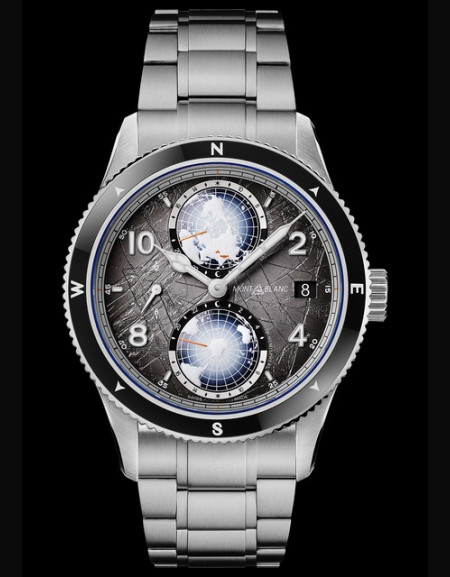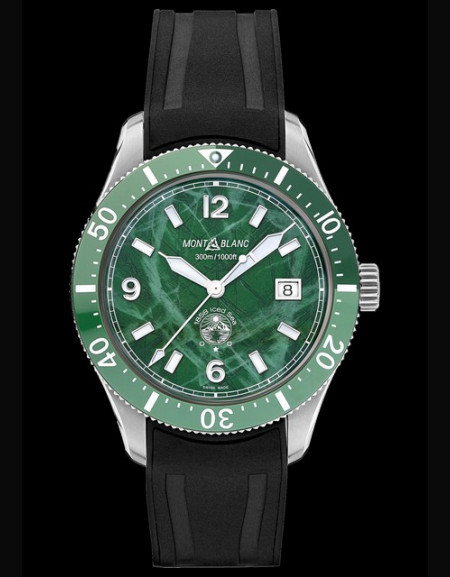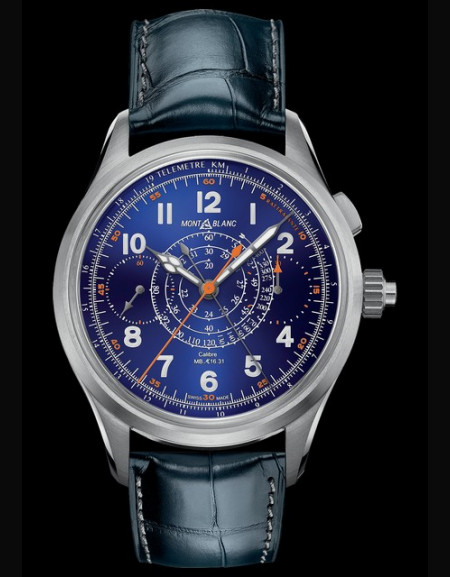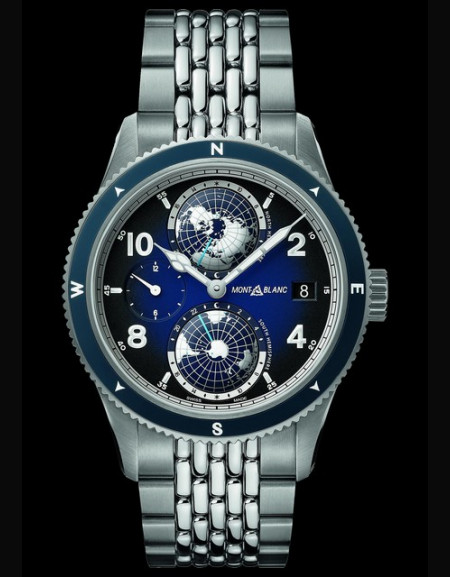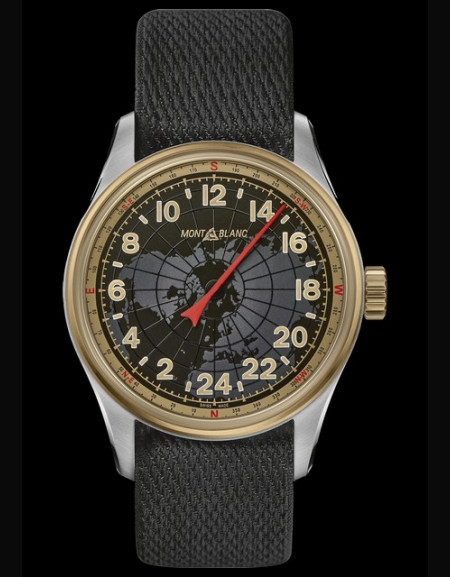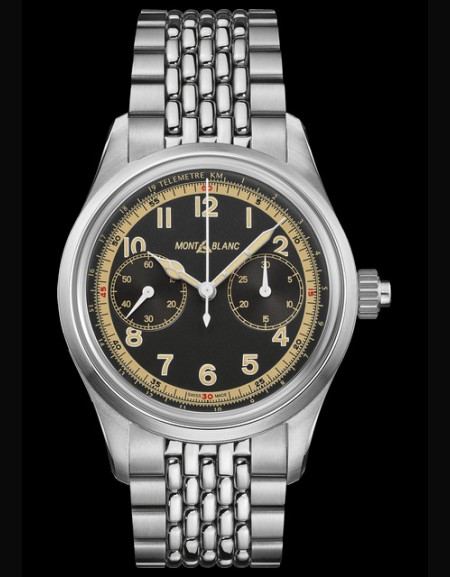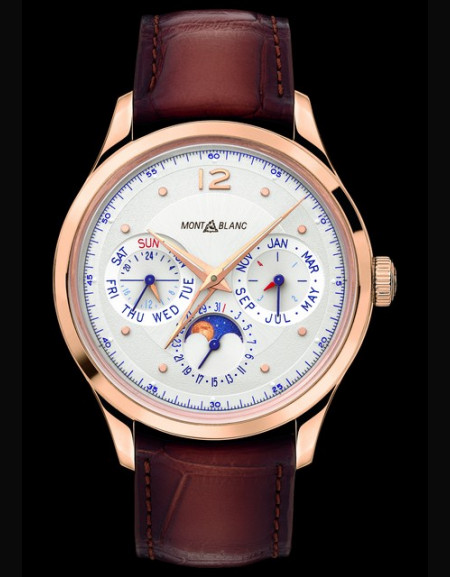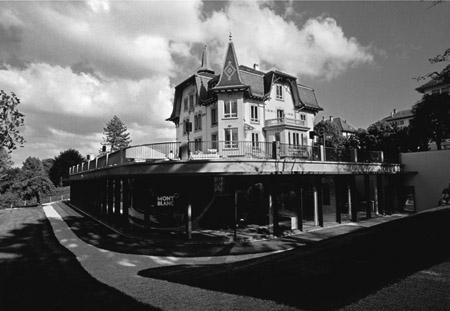1
montblanc

|
||
Montblanc, Montblanc Montre S.A. and Minerva Stories
Montblanc : Montblanc Montre SA
1906 : The Hamburg stationer Claus-Johannes Voss, the Hamburg banker Alfred Nehemias and the Berlin engineer August Eberstein recognise the signs of time and decide to produce fountain pens, placing the cornerstones for the future internationally successful company Montblanc with this 'Joint Venture'.
1913 : Monblanc star becomes the brand logo. All the writing instruments produced by the 'Simplo Filler Pen' company now include the unmistakable rounded star, ...

THE COLLECTIONS

-
Iced Sea Automatic Date 0...
SEE THE DATA SHEETBrand: Montblanc
Collection: Iced Sea
Ref: 134024
Price: 3 600 € -
Iced Sea Automatic Date 0...
SEE THE DATA SHEETBrand: Montblanc
Collection: Iced Sea
Ref: 134022
Price: 3 600 € -
Iced Sea Automatic Date 0...
SEE THE DATA SHEETBrand: Montblanc
Collection: Iced Sea
Ref: 134017
Price: 4 300 € -
1858 Geosphere Annual...
SEE THE DATA SHEETBrand: Montblanc
Collection: Montblanc 1858
Ref: 134027
Price: ON REQUEST -
1858 Geosphere Annual...
SEE THE DATA SHEETBrand: Montblanc
Collection: Montblanc 1858
Ref: 134026
Price: ON REQUEST -
1858 Geosphere 0 Oxygen...
SEE THE DATA SHEETBrand: Montblanc
Collection: Montblanc 1858
Ref: 134019
Price: 9 200 € -
Iced Sea 0 Oxygen Deep 4810
SEE THE DATA SHEETBrand: Montblanc
Collection: Iced Sea
Ref: 133268
Price: 8 900 € -
Montblanc 1858 Geosphere...
SEE THE DATA SHEETBrand: Montblanc
Collection: Montblanc 1858
Ref: 132300
Price: 8 900 € -
Monblanc 1858 The...
SEE THE DATA SHEETBrand: Montblanc
Collection: Montblanc 1858
Ref: MB131155
Price: 40 300 € -
1858 The Unveiled...
SEE THE DATA SHEETBrand: Montblanc
Collection: Montblanc 1858
Ref: MB130988
Price: 60 500 € -
1858 The Unveiled...
SEE THE DATA SHEETBrand: Montblanc
Collection: Montblanc 1858
Ref: MB130987
Price: 45 400 € -
Montblanc Geosphere...
SEE THE DATA SHEETBrand: Montblanc
Collection: Montblanc 1858
Ref: MB130811
Price: 9 300 € -
1858 Automatic Date 0...
SEE THE DATA SHEETBrand: Montblanc
Collection: Montblanc 1858
Ref: MB130984
Price: 3 020 € -
1858 Automatic...
SEE THE DATA SHEETBrand: Montblanc
Collection: Montblanc 1858
Ref: MB130983
Price: 4 900 € -
1858 Iced Sea Automatic...
SEE THE DATA SHEETBrand: Montblanc
Collection: Montblanc 1858
Ref: MB130810
Price: 3 480 € -
1858 Iced Sea Automatic...
SEE THE DATA SHEETBrand: Montblanc
Collection: Montblanc 1858
Ref: MB130807
Price: 2 980 € -
1858 Iced Sea Automatic...
SEE THE DATA SHEETBrand: Montblanc
Collection: Montblanc 1858
Ref: MB130793
Price: 3 180 € -
1858 Geosphere 0 Oxygen...
SEE THE DATA SHEETBrand: Montblanc
Collection: Montblanc 1858
Ref: MB130982
Price: 7 100 € -
-
-
-
-
-
-
Montblanc 1858 Split...
SEE THE DATA SHEETBrand: Montblanc
Collection: Montblanc 1858
Ref: 126006
Price: ON REQUEST -
Montblanc 1858 Geosphere
SEE THE DATA SHEETBrand: Montblanc
Collection: Montblanc 1858
Ref: 125567
Price: 6 000 € -
Montblanc 1858 Geosphere
SEE THE DATA SHEETBrand: Montblanc
Collection: Montblanc 1858
Ref: 125565
Price: 5 700 € -
Montblanc 1858 Automatic 24H
SEE THE DATA SHEETBrand: Montblanc
Collection: Montblanc 1858
Ref: 126007
Price: 2 930 € -
Montblanc 1858 Monopusher...
SEE THE DATA SHEETBrand: Montblanc
Collection: Montblanc 1858
Ref: 125582
Price: 5 100 € -
Montblanc 1858 Monopusher...
SEE THE DATA SHEETBrand: Montblanc
Collection: Montblanc 1858
Ref: 125581
Price: 4 700 € -
Montblanc 1858 Monopusher...
SEE THE DATA SHEETBrand: Montblanc
Collection: Montblanc 1858
Ref: 125583
Price: 5 500 € -
Heritage Perpetual Calendar
SEE THE DATA SHEETBrand: Montblanc
Collection: Heritage
Ref: 119926
Price: 25 100 €
Montblanc, Montblanc Montre S.A. and Minerva Stories
Montblanc : Montblanc Montre SA
1906 : The Hamburg stationer Claus-Johannes Voss, the Hamburg banker Alfred Nehemias and the Berlin engineer August Eberstein recognise the signs of time and decide to produce fountain pens, placing the cornerstones for the future internationally successful company Montblanc with this 'Joint Venture'.
1913 : Monblanc star becomes the brand logo. All the writing instruments produced by the 'Simplo Filler Pen' company now include the unmistakable rounded star, representing the snow-covered peak of Mont Blanc, the highest European mountain, wich symbolises the brand's commitment to the highest quality and finest European craftsmanship.
1924: Launch of the legendary Meisterstück and the beginning of its successfull career as the world's most famous writing instrument. The Meisterstück 149 fountain pen soon became the ultimate symbol fir writing culture and style icon for perfect and timeless design aesthetics.
1926: At the end of the Twenties, 'Montblanc' rapidly expands into a well-known name in more than 60 different countries. Impressive advertising campaigns, like fitting cars with an oversize fountain pen and the Montblanc sign on top and the first advertising planes wich take the Montblanc name into the 'third dimension' attract tremendous attention.
1935 : By issuing 'lifelong' guarantee for the Meisterstück, Montblanc demonstrates that it always pays for the customer to opt for the best. Montblanc succeeds in rounding off the range of writing intruments by taking over a producer of leatherware in Offenbach, Germany: desk accessories are produced under the Montblanc name from now on too.
1996 : Montblanc successfully enters the jewellery field with the Meisterstück jewellerycollection-stylesh accessoires for
men.
1997 : Not just a matter of time. (Montblanc attracts greats attention and recognition among top international jewellers when it participates in the SIHH watch fair in Geneva for the very first time.
Montblanc Montres S.A. Is established in Le Locle - the heart of the Swiss watch industry - to maintain the brand's philosophy of master craftsmanship and to satisfy the high quality expectations mode a Meisterstück watches.
2000: The Meisterstück Sports collection comes to full, active life the release of the release of seven stylish, robust and ruggedly functional timepieces.
2002: Introduction of the new design concept for Montblanc boutiques with the new flaship store on the world's most famous Boulevard Champs Elysées in Paris.
Presentation of the first rectangular Watch from Montblanc - the new PROFILE collection - at the Salon International Haute Horlogerie in Geneva.
2003: Montblanc presents StarWalker, the new generation of writing instruments, and the TimeWalker watch collection for people who are cosmopolitan, dynamic and have a love for pure, aesthetic design.
2007: Montblanc teamed up with Minerva, a Swiss watchmaking manufacture founded in 1858, to preserve 150 years of traditional Swiss watchmaking. The Montblanc Collection Villeret 1858 represents the advent of a new era in Montblanc's history.
It is the perfect alliance of two companies wich deliver the highest satndards of artistry and artisanship in the manufacture of thier products. Such aspirations demand the pasion and tireless dedication of master craftsmen. The resurch: distinct timepieces wich will remain scarce examples of rare perfection.
Minerva
From the foundation of a watchmaking company to the Institut Minerva de Recherche en Haute Horlogerie
In 1858, Charles-Yvan and Hyppolite Robert founded the H. & C. Robert watchmaking factory in Villeret, a village in the St. Imier valley in the Swiss Jura. These were still the early days of a period that would see Switzerland emerge as the world‘s leading watchmaking nation. And like most of the watch manufacturers of the period, the Roberts started out as etablisseurs'. In other words, they purchased movement blanks, parts, cases and dials etc. from other manufacturers and used them to make their own watches. These were fine-quality pocket watches, most of them with a cylinder escapement and a new system for winding the movement and setting the hands via the crown. These had soon established a reputation that went far beyond the borders of Switzerland, as witnessed by the certificates awarded to the C. Robert company at world exhibitions in Antwerp (1885) and Paris (1889).
On 30 July 1887, the Minerva brand name and trademark arrowhead were deposited with the Swiss Federal Office of Intellectual Property. Following the entry of the second generation of the Robert family at the end of the 19th century, the company completed its transformation to a genuine watchmakers‘ workshop: an establishment that developed and produced its own movements, made its own cases and mastered all the skills required for watch production. The sons of company founder Charles-Yvan Robert strengthened the company‘s independence by increasing its vertical range of manufacture.
In 1902 the company started producing the first pocket watch movement with a cylinder escapement developed entirely in-house. In the next ten years, it was to produce a good dozen basic movements of its own. These were mechanisms with cylinder or lever escapements, chronograph functions and stopwatch movements, whose steel levers already had the typical formal features that still distinguish Minerva chronographs from the rest. The 19-line no. 3 calibre, which served as the basis for several other movements, was to become particularly well known.
In 1909 the company was one of the first to make a movement designed especially for wristwatches, which at the time were becoming increasingly popular. Unfortunately, these technological advances were accompanied by several twists of fate for the Robert family, who gradually began to withdraw from everyday business activities.
In 1929 the company was finally renamed Minerva SA.
On 12 June 1935 it was sold to Charles Haussener and Jacques Pelot, who had both been employed by Minerva since 1921. Haussener was in charge of producing the movement blanks, while watch technician Pelot took control of the R&D department. With his indomitable flair, Pelot extended the product range and, among other things, designed a mechanical stopwatch with a 19-line 42 calibre. This ran at a speed of no fewer than 360 000 beats per hour (50 Hertz) and was able to measure times to an accuracy of one-hundredth of a second.
Instead of following the prevailing trend and industrialising production, Minerva opted to keep its existing infrastructure, which was perfectly geared to the manufacture of small but highly exclusive series. As one of very few manufacturers, the company was thus able to draw on the master watchmakers, the original tools and the expertise needed to make mechanical timepieces in keeping with authentic Swiss watchmaking tradition.
In 2007, under Montblanc‘s aegis, Minerva became the Institut Minerva de Recherche en Haute Horlogerie, edicated to classical fine watchmaking and the upholding of traditional skills and special complications. It is thus able to focus completely on its true calling: the art of watchmaking at its consummate best, calling for a wealth of manual skills, authentic Swiss tradition and an extremely high degree of vertical integration. Needless to say, when methods like these are used, production figures are only very small.
Back in 2007, Montblanc made substantial investments to sustain this irreplaceable experience and expertise and to secure it for generations of watch devotees to come. The aim of the Institut is to preserve invaluable skills, to build on them and to foster them to new greatness. One factor of particular importance here is training. The newly founded Institut is intended to function as a kind of think tank, where young watchmakers can meet up to exchange ideas and be initiated into the old traditions, the expertise developed over generations, the rich body of experience and the mentality typical of the true master watchmaker. This purpose, too, was the reason for the Fondation Minerva de Recherche en Haute Horlogerie, for which the capital was supplied by Montblanc. The Foundation began providing financial and logistic support for its first non-profit projects this year. There are also plans for exhibitions, workshops and events for people in the industry, with a view to making what the Institut has to offer accessible to as many interested individuals as possible.
2009: Balance spring production at the Institut de Minerva en Recherche en Haute Horlogerie
But not only the building itself underwent renovation. As part of the extensive work of refurbishment, the watch manufacturing company set up a new workshop that has enabled it to fulfil a dream, with the resources that will equip it to make its own balance springs from start to finish. This has made the Institut Minerva de Recherche en Haute Horlogerie one of the most exclusive watch manufacturers in the world, because only a handful of leading watchmakers still have the wherewithal to do this. Since the company in Villeret also produces key components such as the balance, pallets and escape wheel in its own workshops, it means the Institut is able to tailor-make complete sets of parts for each movement without external assistance.
